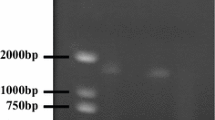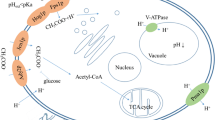Abstract
Saccharomyces cerevisiae is often stressed by the ethanol which accumulates during the production of bioethanol by the fermentation process. The study of ethanol-adapted S. cerevisiae strains provide an opportunity to clarify the molecular mechanism underlying the adaptation or tolerance of S. cerevisiae to ethanol stress. The aim of this study was to clarify this molecular mechanism by investigating the ethanol adaptation-associated intracellular metabolic changes in S. cerevisiae using a gas chromatography–mass spectrometry-based metabolomics strategy. A partial least-squares-discriminant analysis between the parental strain and ethanol-adapted strains identified 12 differential metabolites of variable importance with a projection value of >1. The ethanol-adapted strains had a more activated glycolysis pathway and higher energy production than the parental strain, suggesting the possibility that an increased energy production and energy requirement might be partly responsible for an increased ethanol tolerance. An increased glycine content also partly contributed to the higher ethanol tolerance of the ethanol-adapted strains. The decreased oleic acid content may be a self-protection mechanism of ethanol-adapted strains to maintain membrane integrity through decreasing membrane fluidity. We suggest that while being exposed to ethanol stress, ethanol-adapted S. cerevisiae cells may remodel their metabolic phenotype and the composition of their cell membrane to adapt to ethanol stress and acquire higher ethanol tolerance.



Similar content being viewed by others
References
Aguilera F, Peinado RA, Millán C, Ortega JM, Mauricio JC (2006) Relationship between ethanol tolerance, H+-ATPase activity and the lipid composition of the plasma membrane in different wine yeast strains. Int J Food Microbiol 110:34–42
Bai FW, Anderson WA, Moo-Young M (2008) Ethanol fermentation technologies from sugar and starch feedstocks. Biotechnol Adv 26:89–105
Castro CC, Gunning C, Oliveira CM, Couto JA, Teixeira JA, Martins RC, Ferreira AC (2012) Saccharomyces cerevisiae oxidative response evaluation by cyclic voltammetry and gas chromatography–mass spectrometry. J Agric Food Chem 60:7252–7261
Cui FX, Zhang RM, Liu HQ, Wang YF, Li H (2015) Metabolic responses to Lactobacillus plantarum contamination or bacteriophage treatment in Saccharomyces cerevisiae using a GC-MS-based metabolomics approach. World J Microbiol Biotechnol 31:2003–2013
Demeke MM, Dumortier F, Li Y, Broeckx T, Foulquié-Moreno MR, Thevelein JM (2013) Combining inhibitor tolerance and D-xylose fermentation in industrial Saccharomyces cerevisiae for efficient lignocellulose-based bioethanol production. Biotechnol Biofuels 6:213–223
Ding JM, Huang XW, Zhang LM, Zhao N, Yang DM, Zhang KQ (2009a) Tolerance and stress response to ethanol in the yeast Saccharomyces cerevisiae. Appl Microbiol Biotechnol 85:253–263
Ding MZ, Tian HC, Cheng JS, Yuan YJ (2009b) Inoculum size-dependent interactive regulation of metabolism and stress response of Saccharomyces cerevisiae revealed by comparative metabolomics. J Biotechnol 144:279–286
Dinh TN, Nagahisa K, Hirasawa T, Furusawa C, Shimizu H (2008) Adaptation of Saccharomyces cerevisiae cells to high ethanol concentration and changes in fatty acid composition of membrane and cell size. PLoS ONE 3:e2623
Favaro L, Basaglia M, Trento A, Van Rensburg E, García-Aparicio M, Van Zyl WH, Casella S (2013) Exploring grape marc as trove for new thermotolerant and inhibitor-tolerant Saccharomyces cerevisiae strains for second-generation bioethanol production. Biotechnol Biofuels 6:746–753
Hill J, Nelson E, Tilman D, Polasky S, Tiffany D (2006) Environmental, economic, and energetic costs and benefits of biodiesel and ethanol biofuels. Proc Natl Acad Sci USA 103:11206–11210
Islam MA, Hasanuzzaman M, Rahim NA, Nahar A, Hosenuzzaman M (2014) Global renewable energy-based electricity generation and smart grid system for energy security. Sci World J 2014:197136
Kajiwara S, Suga K, Sone H, Nakamura K (2000) Improved ethanol tolerance of Saccharomyces cerevisiae strains by increases in fatty acid unsaturation via metabolic engineering. Biotechnol Lett 22:1839–1843
Kanshin E, Kubiniok P, Thattikota Y, D’Amours D, Thibault P (2015) Phosphoproteome dynamics of Saccharomyces cerevisiae under heat shock and cold stress. Mol Syst Biol 11:813
Kim HS, Kim NR, Choi W (2011) Total fatty acid content of the plasma membrane of Saccharomyces cerevisiae is more responsible for ethanol tolerance than the degree of unsaturation. Biotechnol Lett 33:509–515
Lam FH, Ghaderi A, Fink GR, Stephanopoulos G (2014) Biofuels. Engineering alcohol tolerance in yeast. Science 346:71–75
Li H, Ma ML, Luo S, Zhang RM, Han P, Hu W (2012) Metabolic responses to ethanol in Saccharomyces cerevisiae using a gas chromatography tandem mass spectrometry-based metabolomics approach. Int J Biochem Cell Biol 44:1087–1096
Ma M, Liu ZL (2010) Mechanisms of ethanol tolerance in Saccharomyces cerevisiae. Appl Microbiol Biotechnol 87:829–845
Martín C, Thomsen MH, Hauggaard-Nielsen H, Belindathomesn A (2008) Wet oxidation pretreatment, enzymatic hydrolysis and simultaneous saccharification and fermentation of clover-ryegrass mixtures. Bioresour Technol 99:8777–8782
Morano KA, Grant CM, Moye-Rowley WS (2012) The response to heat shock and oxidative stress in Saccharomyces cerevisiae. Genetics 190:1157–1195
Nevoigt E (2008) Progress in metabolic engineering of Saccharomyces cerevisiae. Microbiol Mol Biol Rev 72:379–412
Pagliardini J, Hubmann G, Alfenore S, Nevoigt E, Bideaux C, Guillouet SE (2013) The metabolic costs of improving ethanol yield by reducing glycerol formation capacity under anaerobic conditions in Saccharomyces cerevisiae. Microb Cell Fact 12:29
Parawira W, Tekere M (2011) Biotechnological strategies to overcome inhibitors in lignocellulose hydrolysates for ethanol production: review. Crit Rev Biotechnol 31:20–31
Semkiv MV, Dmytruk KV, Abbas CA, Sibirny AA (2014) Increased ethanol accumulation from glucose via reduction of ATP level in a recombinant strain of Saccharomyces cerevisiae overexpressing alkaline phosphatase. BMC Biotechnol 14:42
Simas-Rodrigues C, Villela HD, Martins AP, Marques LG, Colepicolo P, Tonon AP (2015) Microalgae for economic applications: advantages and perspectives for bioethanol. J Exp Bot 66:4097–4108
Swinnen S, Schaerlaekens K, Pais T, Claesen J, Hubmann G, Yang Y, Demeke M, Foulquié-Moreno MR, Goovaerts A, Souvereyns K, Clement L, Dumortier F, Thevelein JM (2012) Identification of novel causative genes determining the complex trait of high ethanol tolerance in yeast using pooled-segregant whole-genome sequence analysis. Genome Res 22:975–984
Szeto SS, Reinke SN, Sykes BD, Lemire BD (2010) Mutations in the Saccharomyces cerevisiae succinate dehydrogenase result in distinct metabolic phenotypes revealed through 1H NMR-based metabolic footprinting. J Proteome Res 9:6729–6739
Tao X, Zheng D, Liu T, Wang P, Zhao W, Zhu M, Jiang X, Zhao Y, Wu X (2012) A novel strategy to construct yeast Saccharomyces cerevisiae strains for very high gravity fermentation. PLoS ONE 7:e31235
Teixeira MC, Raposo LR, Mira NP, Lourenco AB, Sa-Correia I (2009) Genome-wide identification of Saccharomyces cerevisiae genes required for maximal tolerance to ethanol. Appl Environ Microbiol 75:5761–5772
Thomas KC, Hynes SH, Ingledew WM (1994) Effects of particulate materials and osmoprotectants on very-high-gravity ethanolic fermentation by Saccharomyces cerevisiae. Appl Environ Microbiol 60:1519–1524
Toya Y, Shimizu H (2013) Flux analysis and metabolomics for systematic metabolic engineering of microorganisms. Biotechnol Adv 31:818–826
Villas-Bôas S, Højer-Pedersen J, Akesson M, Smedsgaard J, Nielsen J (2005) Global metabolite analysis of yeast: evaluation of sample preparation methods. Yeast 22:1155–1169
Wang Y, Zhang S, Liu H, Zhang L, Yi C, Li H (2015) Changes and roles of membrane compositions in the adaptation of Saccharomyces cerevisiae to ethanol. J Basic Microbiol 55:1417–1426
Wei X, Shi X, Koo I, Kim S, Schmidt RH, Arteel GE, Watson WH, McClain C, Zhang X (2013) MetPP: a computational platform for comprehensive two-dimensional gas chromatography time-of-flight mass spectrometry-based metabolomics. Bioinformatics 29:1786–1792
Westman JO, Mapelli V, Taherzadeh MJ, Franzén CJ (2014) Flocculation causes inhibitor tolerance in Saccharomyces cerevisiae for second-generation bioethanol production. Appl Environ Microbiol 80:6908–6918
Williams KM, Liu P, Fay JC (2015) Evolution of ecological dominance of yeast species in high-sugar environments. Evolution 69:2079–2093
Wimalasena TT, Greetham D, Marvin ME, Liti G, Chandelia Y, Hart A, Louis EJ, Phister TG, Tucker GA, Smart KA (2014) Phenotypic characterisation of Saccharomyces spp. yeast for tolerance to stresses encountered during fermentation of lignocellulosic residues to produce bioethanol. Microb Cell Factories 13:1–13
Winder CL, Dunn WB, Goodacre R (2011) TARDIS-based microbial metabolomics: time and relative differences in systems. Trends Microbiol 19:315–322
Xue YM, Jiang N (2006) Study on ethanol tolerance of Saccharomyces cerevisiae X330 under very high gravity medium. Sheng Wu Gong Cheng Xue Bao 22:508–513
Yang J, Bae JY, Lee YM, Kwon H, Moon HY, Kang HA, Yee SB, Kim W, Choi W (2011) Construction of Saccharomyces cerevisiae strains with enhanced ethanol tolerance by mutagenesis of the TATA-binding protein gene and identification of novel genes associated with ethanol tolerance. Biotechnol Bioeng 108:1776–1787
You KM, Rosenfield CL, Knipple DC (2003) Ethanol tolerance in the yeast Saccharomyces cerevisiae is dependent on cellular oleic acid content. Appl Environ Microbiol 69:1499–1503
Acknowledgements
This work was supported by the Strategic Priority Research Program of the Chinese Academy of Sciences (No. XDB14010301), the Fundamental Research Funds for the Central Universities (No. YS1407) and the Higher Education and High-quality and World-class Universities (No. PY201617).
Author information
Authors and Affiliations
Corresponding author
Ethics declarations
Conflict of interest
The authors declare that they have no conflict of interest.
Electronic supplementary material
Below is the link to the electronic supplementary material.
ESM 1
(PDF 22 kb)
Rights and permissions
About this article
Cite this article
Tian, J., Zhang, S. & Li, H. Changes in intracellular metabolism underlying the adaptation of Saccharomyces cerevisiae strains to ethanol stress. Ann Microbiol 67, 195–202 (2017). https://doi.org/10.1007/s13213-016-1251-1
Received:
Accepted:
Published:
Issue Date:
DOI: https://doi.org/10.1007/s13213-016-1251-1




